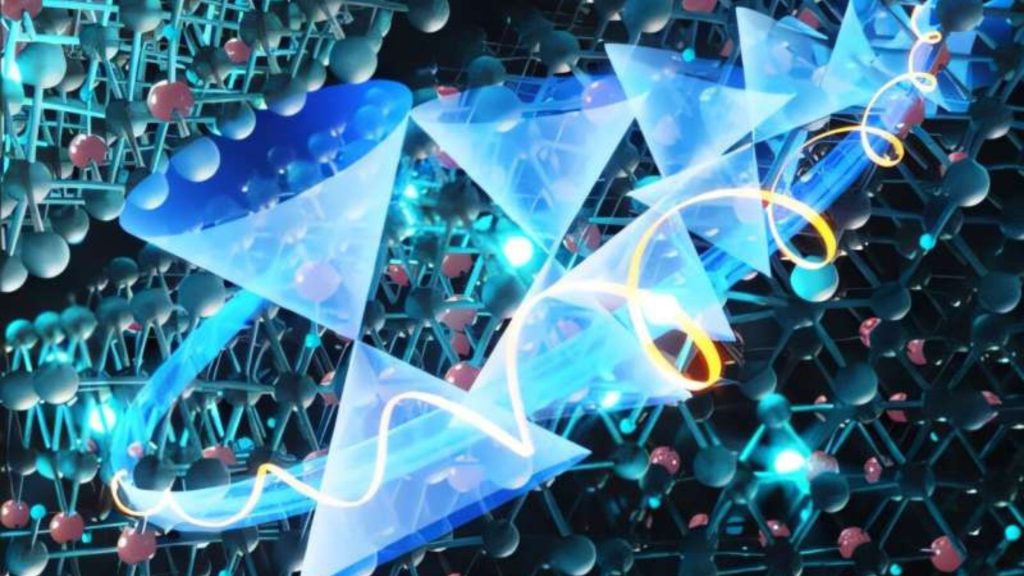New technique uses hydrogen to tune exotic materials for quantum devices – Interesting Engineering

Researchers altered MnSb₂Te₄’s bandstructure by adding and removing hydrogen, creating strongly tilted Weyl nodes.a day agoa day agoa day ago2 days ago2 days ago2 days ago3 days ago3 days ago3 days ago3 days ago19 minutes ago23 minutes agoan hour agoan hour agoan hour ago2 hours ago2 hours ago5 hours ago20 hours agoa day agoJijo MalayilRendering of the tilting of relativistic Dirac cones in the bulk electronic bands of a quasi-two-dimensional (2D) magnetic topological semimetal achieved with insertion of hydrogen that generates tunable low-dissipation chiral charge currents.Krusin LabA team of physicists from the City College of New York (CCNY) has created a new method to control the electronic properties of a magnetic Weyl semimetal. This material has unique features where electrons behave like massless particles called Weyl fermions. These particles are special because their spin and movement are connected, giving them a distinct “handedness.” The technique uses hydrogen cations (H+) to adjust these properties, opening new possibilities for advanced materials and technologies.According to researchers, the discovery could lead to new quantum devices that use unique topological states for advanced technologies like chiral nano-electronics and error-proof quantum computing.Chiral Weyl fermions are massless particles first proposed in theoretical physics but found in condensed matter as excitations in Weyl semimetals. These materials are unique 3D phases with special band crossings, called Weyl nodes, that occur when time-reversal or inversion symmetry is broken. These nodes come in pairs with opposite “handedness,” tied to how a particle’s spin aligns with its momentum. According to researchers, they are topologically protected and act as sources or sinks of Berry curvature, a magnetic-like field in momentum space. This makes Weyl fermions’ behavior unlike any seen in regular metals, enabling phenomena like the chiral anomaly, where their chiral charge is imbalanced under certain conditions. Despite advances, tuning these exotic dynamics in magnetic Weyl semimetals remains complex, as their spin textures can unexpectedly reshape their behavior.In the new research, the team reveals a method to tune topological properties in ferromagnetic Weyl semimetals using hydrogen. By introducing and removing hydrogen in MnSb₂Te₄, researchers transformed the material’s bandstructure, creating strongly tilted Weyl nodes. The method to fine-tune Weyl nodes in a material using hydrogen ions (H+) fixed defects in the Mn-Te bonds and reduced scattering between Weyl nodes. The process revealed that electric charges behave differently depending on the rotation direction of an in-plane magnetic field, clockwise or counterclockwise. This creates low-energy-loss currents, ideal for efficient electronics. The modified Weyl states also show improved properties, including a doubled Curie temperature (the point where magnetism weakens) and a unique “chiral switch.” This switch relies on topological Berry curvature, the chiral anomaly, and hydrogen-altered Weyl nodes, enabling advanced, controllable charge transport.“The major advance of this work is enlarging the breadth of designer topological quantum materials beyond nature’s blueprint,” said Krusin-Elbaum, professor in CCNY’s Division of Science, in a statement.“Tunable topological bandstructures facilitated by hydrogen or other light elements through defect-related pathways expand the availability of accessible platforms for exploring and harnessing topological phases with stunning macroscopic behaviors, opening a path to a potentially disruptive chirality-based implementations in future quantum devices.”The research focuses on uncovering new quantum phenomena, including the Quantum Anomalous Hall (QAH) effect, which allows an insulator to conduct current without energy loss through surface channels, 2D superconductivity, and axion states with quantized thermal transport. According to researchers, these discoveries hold potential for developing energy-efficient technologies. The demonstrated technique is highly versatile and could significantly enhance the capabilities of intrinsic topological magnets, paving the way for advancements in future quantum electronics.The details of the team’s research were published in the journal Nature.Stay up-to-date on engineering, tech, space, and science news with The Blueprint.By clicking sign up, you confirm that you accept this site’s Terms of Use and Privacy PolicyJijo Malayil Jijo is an automotive and business journalist based in India. Armed with a BA in History (Honors) from St. Stephen’s College, Delhi University, and a PG diploma in Journalism from the Indian Institute of Mass Communication, Delhi, he has worked for news agencies, national newspapers, and automotive magazines. In his spare time, he likes to go off-roading, engage in political discourse, travel, and teach languages.a day agoa day agoa day agoa day agoPremiumIE PROFollow
Source: https://interestingengineering.com/science/hydrogen-ions-control-exotic-quantum-material



